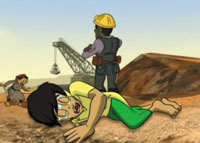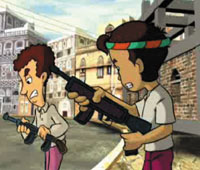
Cartoon films seek to counter Yemeni social ills [Archives:2008/1174/Culture]
July 21 2008
 |
 |
Ahmed is the name of the main character in two cartoon films produced by the Shawthab Foundation for Childhood and Development. The two films are part of a series seeking to enhance the media's role in dealing with children's issues.
In both films, Ahmed is portrayed with brown skin, dark hair, wide black eyes and wearing traditional clothing in most scenes in order to reflect Yemeni children's image as victims of circumstances forced upon them by their communities, whether family or neighbors.
According to the foundation, the first film, “Ahmed is Coming Back,” is based on a true story and was created to show the suffering and pain that smuggled Yemeni children experience.
Ahmed's poor unemployed father sends him to a smuggler to enter Saudi Arabia illegally. During his trip, Ahmed witnesses the death of his friend, who gets bitten by a snake. Unable to survive the hunger, fear and the hard work, Ahmed returns to Yemen by car in a miserable condition.
The 20-minute film ends with the smugglers' arrests, although viewers don't know how this happens. Ahmed's father weeps, promising to find work so as not to repeat the mistake of sending his son away.
Considered the first Yemeni dramatic production in this field, the film achieved great success, winning third place at Cairo's annual Children's Cinema Festival in 2007.
At that festival, the Shawthab Foundation also was nominated for the Arab Gulf Foundation for United Nations Development Organizations (AGFUND) prize provided by Saudi Prince Talal Bin Abdulaziz Al-Saud.
The foundation's second animated film, “Ahmed and the Game of Death,” which was released two weeks ago at an event at the Moevenpick Hotel, focuses on children carrying firearms and was highly critical of the Yemeni tradition of carrying weapons.
This time, Ahmed is portrayed as an educated child from an educated family that rejects the concept of using or carrying weapons. However, this is contrary to Ahmed's neighbor's children, who start carrying weapons following encouragement from their parents.
The film rebukes the Yemeni cultural concept of linking manhood with carrying weapons. “The real weapon is your knowledge and education,” Ahmed's father says while addressing his children. In a shockingly dramatic scene, Ahmed is injured and another child is killed when Salim, another child in their neighborhood, is showing off his pistol.
The film ends with the arrest of Salim's father and Ahmed waking up in the hospital, asking for a weapon. “Here's your weapon,” his father says while handing Ahmed a book. The message is that education can stop this dangerous culture of bearing arms.
Films to raise awareness
“We tried to avoid the errors we made during the first film,” says Mariam Al-Shwafi, secretary-general of the Shawthab Foundation.
Slow action and repetitive scenes were some of these errors that the second film's creators attempted to avoid. “Our establishment contacted various film producers, such as Al-Jazeera, and even schoolchildren in order to get their reactions to the first film, 'Ahmed is Coming Back,' and discover the technical defects in an attempt avoid them and make a good quality film,” Al-Shuafi explains, adding that the second film, “Ahmed and Game of Death,” will play at Cairo's next Children's Cinema Festival.
Whereas “Ahmed is Coming Back” has been distributed to many schools in Sana'a, Hadramout, Taiz, Hajjah, Socotra, Hodeidah, Abyan, Aden and Ibb, “Ahmed and the Game of Death” will be distributed in five Yemeni governorates where weapons-carrying is widespread: Marib, Hajjah, Hodeidah, Al-Dhale' and Ibb. Al-Shwafi adds that it also will be shown at schools, parks, local councils and civil societies.
She notes, “The first film was well-received, not only by Yemeni audiences, but also by organizations outside Yemen, with immigration centers and documentary production centers in Jordan and Qatar requesting copies of it.”
Although the two films reflect topics related to children's rights in Yemen, they haven't been seen on Yemeni television. “Unfortunately, our request to show these films and reach a wider audience in Yemen was rejected by the Information Minister [Hassan Al-Lawzi], who said the films don't reflect the status of Yemeni children,” Al-Shuafi says, adding, “We're now trying again with the Information Ministry to show the second film.”
Kid-made
Al-Shuafi maintains that the idea to make an educational cartoon film came from Yemeni children working with the foundation. Not only did the children come up with the idea, they also drew the characters, narrated the story, suggested the characters' names and voiced them.
“Addressing and communicating with children isn't easy,” Al-Shwafi points out, “so it was important to let them participate in creating the characters.”
In April 2006, the Shawthab Foundation announced a competition for the best cartoon drawing of a Yemeni family in national newspapers.
Five participants were selected from each of the five competing governorates: Sana'a, Aden, Hajjah, Hodeidah and Taiz. A team of special artists, including Mohammed Al-Yemeni, Adel Al-Mawri and two children, went to those governments to collect and evaluate the drawings. “We insisted on involving the children in everything, even the plans and decisions,” Al-Shuafi says.
The winner, Rafah Al-Ashwal, who won YR 100,000 donated by UNICEF, was announced at a June 28, 2006 celebration attended by 120 people, including 30 children. A committee of psychologists, sociologists, young artists and cartoon specialists formed a workshop to evaluate and see what the drawings needed and then completed them before sending them to Cairo to become the films' cartoon characters.
Egypt's AkhnaToon Animation Studio produced the two films, each of which cost $30,000. Al-Shwafi notes, “Shawthab Foundation is planning to produce a third film next month on how to teach children to accept others' opinions.”
The Yemeni touch
The creators of the two films were careful to reflect Yemeni society by keeping the characters in traditional clothing, although all of the scenes were portrayed in urban areas. The building construction and the streets also were depicted in Yemeni style; however, the language of both films was modern standard Arabic.
As Al-Shwafi explains, “This shows that these problems affect all Yemeni children, regardless of their background. It also overcomes the accent dilemma and provides access to all levels of society, which can comprehend standard Arabic.”
She points out that although the two films address children firstly, they also are made to address parents. “We found that parents and society involve themselves in different ways in shaping children's destiny, so the two films were created to raise awareness among both children and parents.”
Short clips dealing with sensitive issues
Al-Shuafi notes that Shawthab Foundation already has produced three animated sketches dealing with instructions to be given to children in an effort to avoid sexual harassment.
“We tried not to shock the children because this topic is very sensitive, so we decided to produce five-minute clips using chants to instruct children on how to avoid [sexual] harassment,” she explains, adding that Ahmed and his family members also play the main roles in these videos.
——
[archive-e:1174-v:16-y:2008-d:2008-07-21-p:culture]


